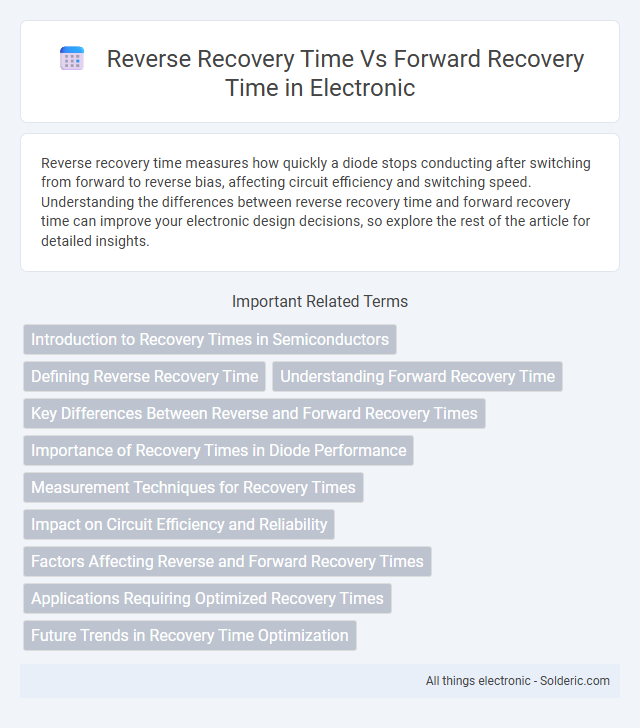Reverse recovery time measures how quickly a diode stops conducting after switching from forward to reverse bias, affecting circuit efficiency and switching speed. Understanding the differences between reverse recovery time and forward recovery time can improve your electronic design decisions, so explore the rest of the article for detailed insights.
Comparison Table
| Feature | Reverse Recovery Time (trr) | Forward Recovery Time (tfr) |
|---|---|---|
| Definition | Time for a diode to switch from conduction in forward bias to blocking in reverse bias. | Time for a diode to start conducting after switching from reverse bias to forward bias. |
| Significance | Impacts switching losses and efficiency in high-speed circuits. | Affects delay in conduction start during switching operations. |
| Measurement | Measured during transition from forward conduction to blocking state. | Measured during transition from blocking to forward conduction. |
| Typical Range | Nanoseconds to microseconds depending on device type. | Usually shorter than reverse recovery time, in nanoseconds range. |
| Device Impact | Critical in power diodes, MOSFET body diodes, and high-speed switching devices. | Important in fast switching diodes and circuits requiring minimal conduction delay. |
Introduction to Recovery Times in Semiconductors
Recovery times in semiconductors, including reverse recovery time and forward recovery time, are critical parameters defining diode switching performance. Reverse recovery time refers to the interval required for a diode to cease conducting after switching from forward to reverse bias, significantly impacting switching losses and efficiency in power electronics. Forward recovery time measures the delay a diode exhibits when transitioning from a non-conducting state to full forward conduction, influencing the device's response speed and voltage drop behavior.
Defining Reverse Recovery Time
Reverse recovery time (trr) is the duration a diode takes to switch from the conducting forward-biased state to the non-conducting reverse-biased state, crucial in fast switching applications. It defines the interval during which stored charge carriers are cleared from the junction, impacting switching losses and efficiency in power electronics. Compared to forward recovery time, which measures the delay in reaching the forward conduction state, reverse recovery time significantly affects the diode's performance in high-frequency circuits.
Understanding Forward Recovery Time
Forward recovery time measures the interval for a diode to switch from the forward-conducting state to a stable voltage after current starts flowing. This parameter is essential for high-speed switching applications, directly impacting efficiency and performance in circuits. Understanding forward recovery time helps you optimize diode selection to minimize power loss and enhance overall device responsiveness.
Key Differences Between Reverse and Forward Recovery Times
Reverse recovery time measures how quickly a diode stops conducting after the current reverses, affecting switching speed and power losses in high-frequency circuits. Forward recovery time refers to the delay before a diode reaches steady-state conduction when turned on, impacting initial voltage drop and response time. Understanding these key differences helps optimize your circuit's efficiency and performance in rectification and switching applications.
Importance of Recovery Times in Diode Performance
Recovery times in diodes critically impact switching efficiency and overall circuit performance, with reverse recovery time (trr) defining how quickly a diode can stop conducting after forward bias is removed. Forward recovery time affects how rapidly a diode can start conducting when forward voltage is applied, influencing signal integrity in high-speed applications. Understanding and optimizing these recovery times ensures Your power electronics achieve low losses, minimized electromagnetic interference, and improved switching reliability.
Measurement Techniques for Recovery Times
Measurement techniques for reverse recovery time often involve using an oscilloscope to observe the diode's current waveform transition from forward conduction to reverse blocking, capturing the time interval where the diode recovers its blocking capability. Forward recovery time measurement typically employs a similar approach, focusing on the voltage buildup across the diode when it is switched from reverse bias to forward conduction. Precise timing measurements require test circuits with controlled current steps and accurate triggering methods to ensure your analysis of semiconductor switching characteristics is reliable and reproducible.
Impact on Circuit Efficiency and Reliability
Reverse recovery time significantly affects circuit efficiency by causing additional power loss during switching due to stored charge that must dissipate, leading to increased heat and reduced overall performance. Forward recovery time impacts the speed at which a diode reaches its conducting state, influencing switching speed but typically resulting in lower energy dissipation compared to reverse recovery. Optimizing your circuit's reliability requires minimizing reverse recovery time to reduce thermal stress and improve efficiency, especially in high-frequency applications.
Factors Affecting Reverse and Forward Recovery Times
Reverse recovery time and forward recovery time are influenced by semiconductor material properties, junction design, and operating temperature. Carrier injection levels and recombination rates within the diode's depletion region significantly impact the reverse recovery time, while forward recovery time depends on the charge carrier transit time and contact resistance. Your choice of diode for high-speed switching applications should consider these factors to optimize performance and efficiency.
Applications Requiring Optimized Recovery Times
Applications requiring optimized recovery times, such as high-frequency switching power supplies and motor drives, prioritize minimizing reverse recovery time to reduce switching losses and electromagnetic interference. Forward recovery time, important in fast rectification scenarios like power factor correction circuits, influences the efficiency and thermal management of the device during turn-on transitions. Selecting diodes or transistors with tailored reverse and forward recovery times enhances overall performance and reliability in sensitive electronic systems.
Future Trends in Recovery Time Optimization
Future trends in recovery time optimization emphasize advanced semiconductor materials such as Silicon Carbide (SiC) and Gallium Nitride (GaN), significantly reducing both reverse recovery time and forward recovery time in high-speed switching devices. Techniques like smart diode designs and improved gate control strategies are accelerating recovery processes, enhancing the efficiency of power electronics in electric vehicles and renewable energy systems. Your choice of components leveraging these innovations can drastically improve performance and energy savings in next-generation circuits.
Reverse recovery time vs forward recovery time Infographic

 solderic.com
solderic.com